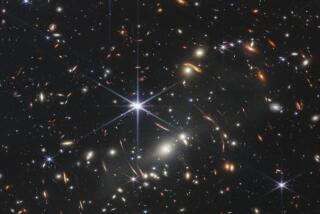Awaiting Proof for Physicists’ Theories
- Share via
Physics is a curious hybrid: part matter, part mind.
Experimentalists try to wring truth out of nature with delicately wrought hardware that often weighs tons and costs millions. Theorists try to seduce nature with nothing fancier than paper and pen (or sometimes computer). Discoveries can be considered valid only when nature speaks the same truths in both languages: experiment and theory.
During the past 20 years, some theorists who study the fundamental ingredients of nature have climbed far out on theoretical limbs because the experiments necessary to test their ideas seemed too difficult, or too expensive, or both.
They’ve sought truth in visions of a universe of 11 dimensions, woven together from tiny vibrating loops of “string.”
These string theories--as well as other far-out theoretical excursions--make a lot of mathematical sense, and solve a lot of problems. The question is: Are they true? Do they really describe the universe we live in?
Many physicists are doubtful.
“We’re in the realm of the theorists’ imaginations,” said UC Berkeley astrophysicist Bernard Sadoulet. “That’s a vast territory. I don’t want to spend my lifetime testing ideas that some theorist dreamed up in five minutes.”
This distaste for untamed theory is one reason physicists are eagerly awaiting the results from a host of major experiments planned for various times during the next 10 years. Among the critical questions seeking answers: What is the universe made of? Why does matter have mass? What is the “dark matter” that seems to make up most of the universe? What is the “weight” of empty space? Why does matter exist at all?
Some experiments look deep into space, asking: What’s out there? Others delve inside the atom, asking: What’s in there?
If the pieces fit, the physicists will know they’re asking the right questions--and correctly interpreting the answers.
Most eagerly anticipated is evidence for “supersymmetry,” a proposed but as yet undiscovered property of nature that would have to be true if many new theories are on the right track.
A supersymmetric universe would pair every known particle with an as yet undiscovered partner that is opposite in many respects. Each electron would pair with an as yet undiscovered “selectron,” each quark with a “squark.”
In the hot, early universe, these partner particles would have existed on an equal footing with familiar particles. Today, however, they are extremely scarce and must be created in high-energy bursts by particle accelerators to be studied.
If the universe turns out to be truly supersymmetric, it would contain a degree of order and symmetry not yet seen. That now-hidden, orderly structure could go a long way toward explaining everything from the origin of matter to the energy of empty space.
Currently, these superpartners are just beyond the reach of experiment. They could be created and detected as early as next year at the Fermi National Accelerator Laboratory outside Chicago. Even if Fermilab doesn’t find them, most physicists believe a much more powerful machine under construction in Europe, the Large Hadron Collider, will produce and detect them within a decade--establishing supersymmetry as a fact of nature.
These same particle accelerators will also be searching for another missing member of the particle family tree. Known as the Higgs boson, this particle would be what physicist Frank Wilczek of the Institute for Advanced Study in Princeton calls “a chip off the old vacuum.” The Higgs is part of empty space itself, the structure of the vacuum that slows down particles and gives them mass. If the Higgs is understood, physicists might finally understand why particles such as electrons and quarks come in three distinct families. It’s one of the most fundamental questions in physics.
*
While the biggest accelerators will look for extremely heavy superparticles--or sparticles--and Higgs bosons, a new machine going online at the Stanford Linear Accelerator will try to find out why matter ever so slightly outweighs antimatter in the universe--even though the two are mirror images and annihilate each other when they meet. The minuscule “leftover” amount of matter gives rise to every atom and star in the universe.
This same experiment and others like it will also begin to answer the question: Why does time flow in one direction only?
Other particle physicists will be trying to find out why certain ghostlike particles called neutrinos appear to spontaneously alter their mass in flight. Others--including Sadoulet--have designed a multitude of clever traps to find the “dark matter” believed to make up most of the cosmos.
While exploring the inner space of subatomic particles will provide important clues to unraveling outstanding mysteries, critical evidence is also beginning to stream in from outer space.
Two new major satellites--one from NASA, one from Europe--are getting ready to take a closer look at the afterglow of the Big Bang, the so-called cosmic microwave background. These earliest bits of light come stamped with a clear imprint of the primordial structure of the universe that evolved into everything, including Earth and life.
“Everything you see in the universe--clusters, galaxies, stars, planets, people, poodles, pond scum, everything--comes from fluctuations [from that era],” said University of Chicago astrophysicist Rocky Kolb.
Another look at the structure of outer space is already on its way from the Sloan Digital Sky Survey, which is producing a map of epic proportions. Because the structure seen today emerged from tiny fluctuations in the original seed that formed the universe, the map will also give many clues to the fundamental character of the universe at the first visible moment of time.
Curiously, much of the new computer technology that makes such a collection of data possible came from accelerator experiments used to probe inner space.
Between theory and experiment, physicists are confident that the puzzles will be solved. But if history is any guide, an equally intriguing set of new mysteries will take their place. What these might be is anybody’s guess.
As the great British experimentalist Michael Faraday once put it: “Nothing is too wonderful to be true.”
(BEGIN TEXT OF INFOBOX / INFOGRAPHIC)
Big Bang Afterglow
*
The afterglow of the fiery Big Bang--now cooled to nearly absolute zero (minus 460 degrees Fahrenheit)--pervades all space and is extremely uniform in all directions across the sky. Tiny temperature variations in this background radiation provide clues to the universe’s structure at the earliest moments of time. Cooler, denser, regions mark places where matter was concentrated. Several planned satellites will map these signals from the birth of the universe in unprecedented detail, providing answers about everything from the nature of dark matter to the energy of empty space.
*
A. COBE: NASA’s Cosmic Background Explorer satellite provided a map of the tiny temperature variations seen in the microwave background radiation for the first time in 1992. Shading variations reflect temperature differences at the level of a few parts per million.
*
B. MAP: NASA’s next-generation Microwave Anisotropy Probe will provide much more detailed information about the vanishingly small temperature fluctuations. The map shown is a simulation of what scientists expect to see.
*
The temperature of the cosmic microwave background radiation is extremely uniform across the sky, 2.728 degrees Kelvin, or about 3 degrees above absolute zero. Temperature of the warmer regions is 0.0002 degrees K warmer than that of the cooler regions, shown here by shading variations.
*
Source: NASA; Researched by NONA YATES/Los Angeles Times






